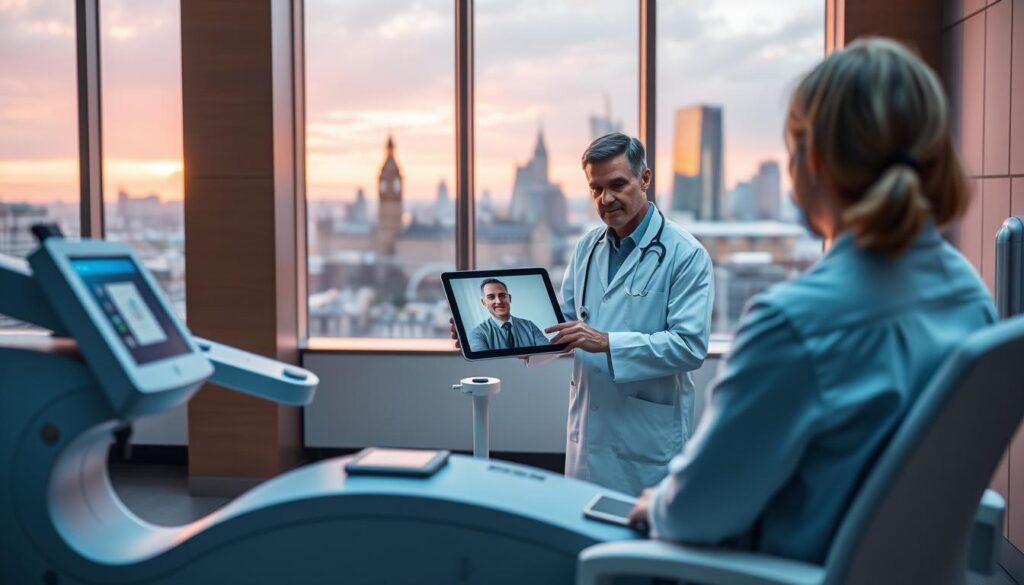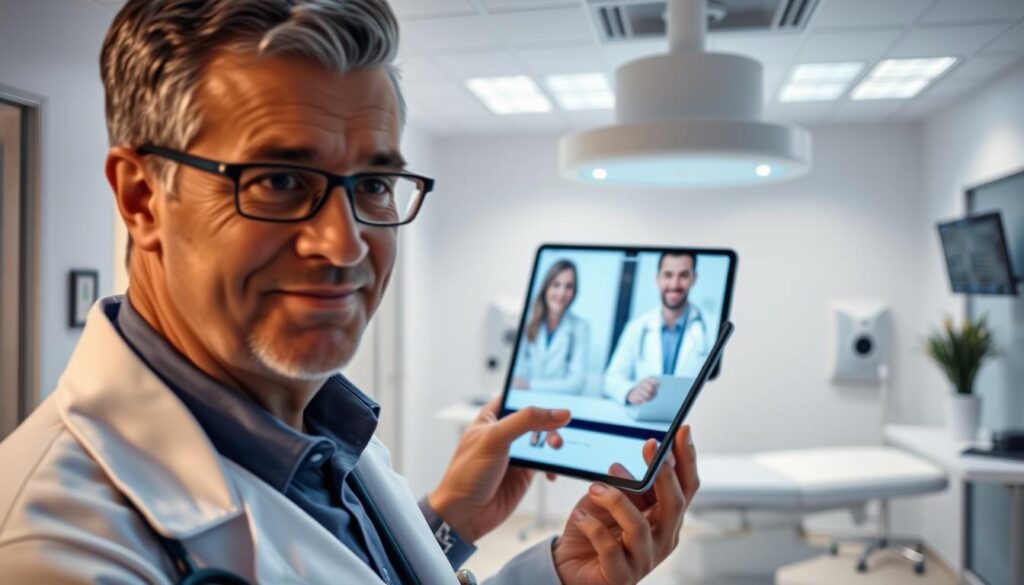Telehealth services UK have rapidly transformed the way healthcare is delivered across the country. Driven by the COVID-19 pandemic, these digital health solutions—such as online GP consultations and remote patient monitoring—have made medical care more accessible and convenient for millions. As demand continues to grow, telehealth is reshaping the future of the NHS and highlighting the urgent need for stronger digital infrastructure and data security.

The rise of telemedicine is huge, a report by the Health Committee of the OECD shows. This change brings many benefits. But, it also shows we need better data management and infrastructure for virtual healthcare.
Key Takeaways
- Telehealth services have seen a significant increase in the UK post-pandemic.
- Digital consultations are making healthcare more accessible and convenient.
- Telemedicine growth highlights the need for better data handling.
- Virtual healthcare marks a big change in how we get medical care.
- We need better infrastructure to support the growth of virtual healthcare.
The Evolution of Healthcare Delivery in the UK
The UK’s healthcare system has changed a lot over time. This change is thanks to new technology and the needs of patients. Before, people would see their doctor face-to-face.
Traditional Healthcare Models and Their Limitations
The old way of getting healthcare in the UK had big problems. For example, people in rural areas had to travel far to see a doctor. Long waiting times were also a big issue, leading to late diagnoses and treatments. It was hard for those with busy lives to get care.

The Catalyst of COVID-19 for Digital Transformation
The COVID-19 pandemic changed healthcare in the UK fast. It made healthcare providers use telemedicine and online services quickly. This let patients get care safely at home, cutting down infection risks and improving health outcomes. The pandemic sped up the growth of digital healthcare, making it better and more accessible for everyone.
Understanding Virtual Healthcare Services
Telehealth technology is changing how healthcare is delivered in the UK. It has made it easier for people to get medical help from home. This is thanks to digital health solutions being added to the healthcare system.
Types of Telehealth Services Available in the UK
The UK has many telehealth services. These include:
- Real-time two-way communication via telephone or video link, enabling patients to consult with healthcare providers remotely.
- Remote patient monitoring using wearable devices, which track vital signs and other health metrics.
- Storing or sharing medical data, such as medical records and test results, to facilitate coordinated care.
These services help a lot of people. This includes those with chronic conditions, mobility issues, or those living far from healthcare services.
How Virtual Consultations Work
Virtual consultations let patients talk to healthcare providers online. Here’s how it works:
- Booking an appointment through a healthcare provider’s website or app.
- Receiving a secure link or invitation to join a virtual consultation at the scheduled time.
- Using a computer, smartphone, or tablet with a camera and microphone to communicate with the healthcare provider.
During a virtual consultation, healthcare providers can check symptoms, give diagnoses, and suggest treatments. It’s like an in-person visit but online. This makes healthcare more accessible and saves time and travel.
The Rise of Virtual Healthcare in the UK: Is the Future Online?
The UK’s healthcare system is changing fast with the rise of virtual healthcare. This change is thanks to new technology and what patients want. We need to look at what’s making virtual healthcare popular and what the future holds.
Current Adoption Rates and Growth Trends
The online doctor consultations market in the UK is set to hit US$294.30m by 2024. It’s growing at 4.58% each year. By 2028, it’s expected to reach US$352.10m. This shows a big move towards virtual healthcare.
Telehealth adoption is on the rise. People like how easy and accessible it is. This is making more patients and doctors use it.
More people want digital health solutions. As tech gets better, patients feel more okay with online doctor visits. This is making more people use these services.
NHS Digital Initiatives and Private Sector Innovations
The NHS is pushing for digital health. NHS Digital is leading with telehealth services to better care for patients. Private companies are also bringing new ideas to virtual healthcare, like online GP visits.
These efforts are making healthcare better and more accessible. The NHS and private sector are using tech to make healthcare better for everyone.
Patient Experiences and Case Studies
The rise of e-health services has changed how patients experience healthcare. Now, virtual GP appointments are common. It’s important to look at the good and bad sides of this change.
Success Stories from Virtual GP Appointments
Many patients love telemedicine, with about two in five preferring it over face-to-face visits. They say it’s convenient, saves time, and is easier to get to.
For example, someone with mobility issues can see their GP from home. This means no long trips to the clinic. This makes patients happier and gets them better care.
Challenges Faced by Patients and Practitioners
But, there are downsides to virtual healthcare. Some patients find it hard to use technology. Others need to see a doctor in person for some health issues. Doctors also face new challenges, like learning new systems and keeping care quality high.
To fix these problems, good training and support are key. This helps both patients and doctors. With these steps, the UK’s healthcare can keep getting better for everyone.
Regulatory Framework and Policy Considerations
The rise of remote healthcare solutions in the UK has led to a review of current rules and policies. As telehealth grows, understanding the rules that guide it is key.
The NHS has been leading in setting rules for telehealth services. These rules aim to make sure telehealth is safe and works well.
NHS Guidelines for Telehealth Services
The NHS has set clear rules for telehealth services. These rules focus on the quality of care and keeping patients safe. They cover things like how to manage telehealth services, getting patient consent, and the technical needs of telehealth platforms.
Key aspects of NHS guidelines include:
- Ensuring telehealth services fit into current care paths
- Guiding on who should use telehealth and how to assess them
- Setting up rules for safe data sharing and storage
Data Protection and Patient Confidentiality
Keeping patient data safe and private is critical in telehealth. The NHS has strong measures in place to protect patient data. These follow rules like the General Data Protection Regulation (GDPR) and the Health and Social Care Act 2012.
Key measures include:
- Encrypting patient data when it’s sent and stored
- Using secure ways for patients and healthcare providers to log in
- Regular checks to make sure data protection rules are followed
Future Policy Directions and Funding
The future of telehealth in the UK will be influenced by new policies and funding. The NHS Long Term Plan’s focus on digital-first primary care is a big factor. It aims to make more primary care services available online.
| Policy Initiative | Description | Impact on Telehealth |
| NHS Long Term Plan | Commitment to digital-first primary care | More access to telehealth services |
| GDPR Compliance | Strong data protection measures | Better patient privacy and trust |
| Telehealth Funding Initiatives | Investment in telehealth infrastructure and services | More telehealth services across the UK |
Conclusion: Balancing Innovation with Quality Care
The rise of virtual healthcare in the UK is changing how we get medical care. It makes us wonder: is the future online? As telehealth tech gets better, we must keep quality care at the top.
Virtual healthcare could make getting medical help easier and faster. But, it also brings challenges. We must make sure new telehealth tech doesn’t compromise patient safety or care quality.
By learning about healthcare’s evolution, the services telehealth offers, and the rules around it, we can use virtual healthcare wisely. The UK’s healthcare system can get better by using telehealth and focusing on quality care.
FAQ
What is virtual healthcare, and how does it work in the UK?
Virtual healthcare, or telehealth, uses digital tech for remote health services. In the UK, it means video calls, phone chats, or messages to talk to doctors. This cuts down on the need for face-to-face visits.
What are the benefits of using telehealth services in the UK?
Telehealth in the UK makes healthcare easier to get. It’s convenient and quick, saving time and travel. It also helps doctors reach more people, even in remote areas.
What types of telehealth services are available in the UK?
The UK offers many telehealth services. You can get virtual GP visits, specialist talks, mental health help, and monitor chronic conditions. You can use NHS online, private services, or apps to access these.
Is my personal data protected when using telehealth services in the UK?
Yes, your data is safe with telehealth in the UK. The NHS and GDPR set strict rules. Providers must keep your data secure and private.
Can I access telehealth services if I don’t have a smartphone or computer?
Yes, you can use phone calls for telehealth services in the UK. This means you can get help without needing a smartphone or computer.
How do I know if a telehealth service is legitimate and trustworthy?
Check if a telehealth service is from a known healthcare provider. Look for NHS or well-known private companies. Make sure it’s registered and has good reviews.
What are the limitations of telehealth services in the UK?
Telehealth has its limits, like tech problems and not being able to do all tests. But, providers are working to make it better.
Will telehealth services replace traditional in-person healthcare services in the UK?
Telehealth won’t replace in-person care. It’s meant to add flexibility and choice. Many are using both to offer better care.
How can I access telehealth services through the NHS?
Contact your GP or use the NHS App or NHS 111 online. Many NHS trusts also offer video and phone calls.
Are telehealth services available for children and vulnerable adults?
Yes, the UK offers telehealth for kids and vulnerable adults. There are special services for them, including paediatric care and support for disabilities.



